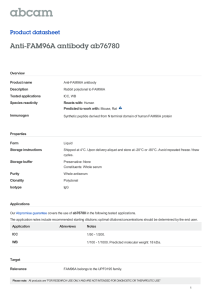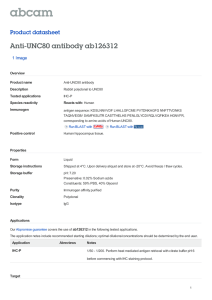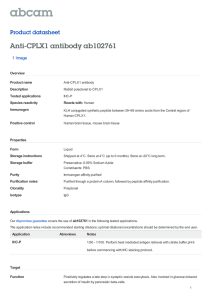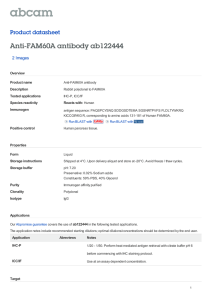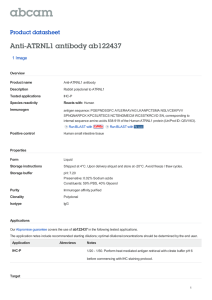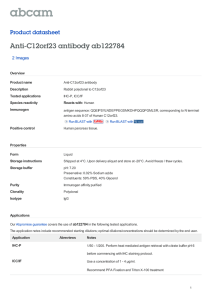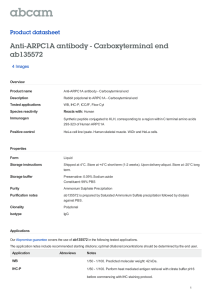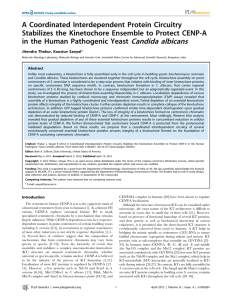Anti-KChIP2 antibody - Carboxyterminal end ab66741 Product datasheet 1 References 1 Image
advertisement
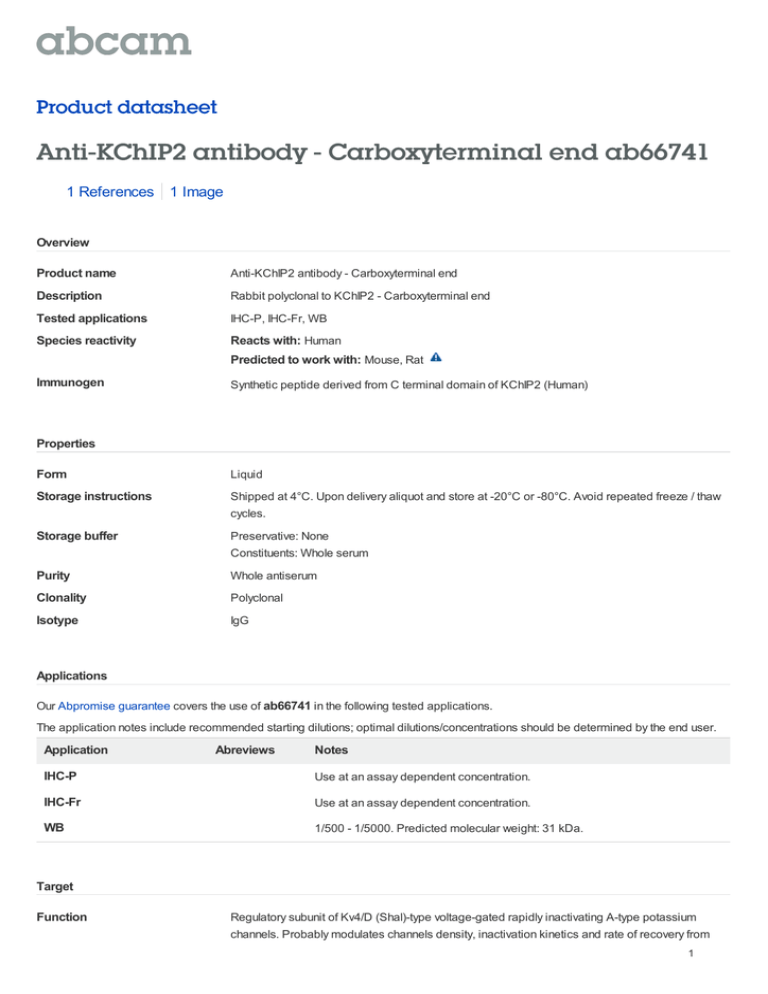
Product datasheet Anti-KChIP2 antibody - Carboxyterminal end ab66741 1 References 1 Image Overview Product name Anti-KChIP2 antibody - Carboxyterminal end Description Rabbit polyclonal to KChIP2 - Carboxyterminal end Tested applications IHC-P, IHC-Fr, WB Species reactivity Reacts with: Human Predicted to work with: Mouse, Rat Immunogen Synthetic peptide derived from C terminal domain of KChIP2 (Human) Properties Form Liquid Storage instructions Shipped at 4°C. Upon delivery aliquot and store at -20°C or -80°C. Avoid repeated freeze / thaw cycles. Storage buffer Preservative: None Constituents: Whole serum Purity Whole antiserum Clonality Polyclonal Isotype IgG Applications Our Abpromise guarantee covers the use of ab66741 in the following tested applications. The application notes include recommended starting dilutions; optimal dilutions/concentrations should be determined by the end user. Application Abreviews Notes IHC-P Use at an assay dependent concentration. IHC-Fr Use at an assay dependent concentration. WB 1/500 - 1/5000. Predicted molecular weight: 31 kDa. Target Function Regulatory subunit of Kv4/D (Shal)-type voltage-gated rapidly inactivating A-type potassium channels. Probably modulates channels density, inactivation kinetics and rate of recovery from 1 inactivation in a calcium-dependent and isoform-specific manner. In vitro, modulates KCND2/Kv4.2 and KCND3/Kv4.3 currents. Involved in KCND2 and KCND3 trafficking to the cell surface. Tissue specificity Expressed in brain. Colocalizes with KCND2 in excitatory neurons including cortical and hippocampal CA1 pyramidal cells. Isoform 3 is expressed in heart and in umbilical vein endothelial cells. Not expressed in fetal heart. Sequence similarities Belongs to the recoverin family. Contains 4 EF-hand domains. Post-translational modifications Palmitoylated. Palmitoylation enhances association with the plasma membrane. Cellular localization Cell membrane. Form There are 9 isoforms produced by alternative splicing. Anti-KChIP2 antibody - Carboxyterminal end images Ab66741 staining human normal pineal gland. Staining is localised to the cell membrane and cytoplasm. Left panel: with primary antibody at 1:1000. Right panel: isotype control. Immunohistochemistry (Formalin/PFA-fixed Sections were stained using an automated paraffin-embedded sections)-KChIP2 antibody - system DAKO Autostainer Plus , at room Carboxyterminal end(ab66741) temperature. Sections were rehydrated and antigen retrieved with the Dako 3-in-1 antigen retrieval buffer EDTA pH 9.0 in a DAKO PT Link. Slides were peroxidase blocked in 3% H2O2 in methanol for 10 minutes. They were then blocked with Dako Protein block for 10 minutes (containing casein 0.25% in PBS) then incubated with primary antibody for 20 minutes and detected with Dako Envision Flex amplification kit for 30 minutes. Colorimetric detection was completed with diaminobenzidine for 5 minutes. Slides were counterstained with Haematoxylin and coverslipped under DePeX. Please note that for manual staining we recommend to optimize the primary antibody concentration and incubation time (overnight incubation), and amplification may be required. Please note: All products are "FOR RESEARCH USE ONLY AND ARE NOT INTENDED FOR DIAGNOSTIC OR THERAPEUTIC USE" Our Abpromise to you: Quality guaranteed and expert technical support Replacement or refund for products not performing as stated on the datasheet Valid for 12 months from date of delivery 2 Response to your inquiry within 24 hours We provide support in Chinese, English, French, German, Japanese and Spanish Extensive multi-media technical resources to help you We investigate all quality concerns to ensure our products perform to the highest standards If the product does not perform as described on this datasheet, we will offer a refund or replacement. For full details of the Abpromise, please visit http://www.abcam.com/abpromise or contact our technical team. Terms and conditions Guarantee only valid for products bought direct from Abcam or one of our authorized distributors 3
